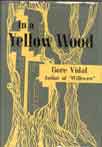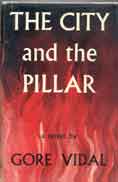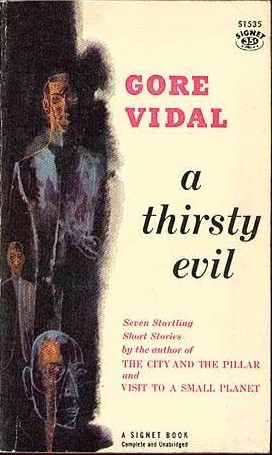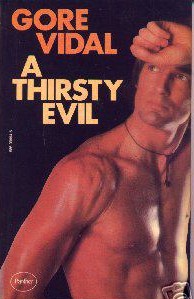The Early Fiction of Gore
Vidal: 1946-1956
During his teen-age years, Vidal tried numerous times to write a
novel.
Fragments of those books remain for perusal among his archival papers at
Harvard.
Finally, while aboard a World War II transport vessel, and later
in a military hospital, he
completed his first novel, Williwaw. He was 21 at the time of the
book's publication. The seven novels that followed it in the 1940s and
1950s found
Vidal trying on a variety of voices and forms and telling a wide range of
stories. But none had the impact on his career like his third novel,
The City and the Pillar, which made him notorious at age 23.

Williwaw (1946)
Vidal's first novel - written when he was 19 and recovering from
rheumatoid arthritis that flared up
during his military service - takes place aboard an Army FS boat in
the Aleutian Islands near Alaska. The title is an Indian word for a big
wind, peculiar to that region of the world, which sweeps suddenly down
from the mountains toward the sea. Such a wind occurs during the dramatic
climax of the novel, which explore its milieu in lean, taut style. It's a
swift read, with well-constructed characters, and it coolly captures the
daily routines of men on the fringe of war. And like many books of men at
war, it has a moral ambiguity, although in Vidal's nascent fictional
world, there is ultimately no moral reckoning. More than 50 years after
its publication, the book remains in print. In the 1950s, the paperback
first edition was published under the title Dangerous Voyage,
presumably because the word "williwaw" was too off-putting for general
audiences. (Read the first
chapter of Williwaw.)

In a Yellow Wood (1947) After returning
from the war, Vidal took a job for several months at Dutton, his
publisher. He translated this work-a-day life, which he deplored, into the
character of Robert Holton, a young World War II veteran who works at a
New York brokerage house and has a promising future. But he's dissatisfied
with his mundane life, and during one 24-hour period, he comes to a
crossroads - hence the book's title, borrowed from the Robert Frost poem
The Road Not Taken. ("Two roads diverged in a yellow wood,/And
sorry I could not travel both/And be one traveler.") An extraordinarily
observant novel, it's moody, moving and rather melancholy. It also shows
Vidal exploring, for the first time, the New York nightlife he'll look at
more deeply in future books. The dust jacket for the first edition says of
this portrayal: "Vidal is merciless in his dissection of the social
phonies, the artistic hangers-on, the frustrated homosexuals." This book
has been out of print in the U.S. since 1947 and was last published in the
U.K. in 1979.

The City and the Pillar (1948)
Tired of "playing it safe," Vidal published this novel - against his
publisher's advice - and changed the
course of his career. The daily New York Times and other
mainstream publications refused to
review his next five novels, and eventually Vidal turned to writing
teleplays and screenplays to
make money. The City and the Pillar tells the story of Jim
Willard, who goes on a post-graduation
weekend in the woods with his best friend Bob Ford. The two fall into an
erotic embrace after skinny
dipping and spend the weekend having mutually satisfying sex. Bob ships
off to war, and Jim,
after a stint in the military himself, spends several years in New York
and Los Angeles, drifting into relationships
with an Errol Flynn-like movie star and an alcoholic novelist, all the
while anticipating a reunion with his beloved Bob.
But by the time they reunite, Bob has settled into his heterosexual life -
the adventure by the river apparently having
become for him just a vague memory of boyhood silliness.
Vidal revised
this novel heavily in 1965, changing the
climactic ending between Jim and Bob in a New York hotel room. The 1948
version has long been out of print. Years later, Vidal
revealed that his own boyhood love was Jimmie
Trimble, his best friend at
St. Albans School when they were both around age 14. Jimmie was killed in
World War II, and the dedication on The City and the
Pillar reads, "For the Memory of J.T." It's a memory that would haunt
Vidal for the rest of his life, and he would return to it often in his
fiction and nonfiction. This novel appeared in one more hardcover
edition, in 1995, reprinted with the seven stories from Vidal's 1956
short story collection A Thirsty Evil. Many of those stories
have homoerotic elements, thus the 1995 volume sought to
capitalize on the growing market for gay-themed fiction.

The Season of Comfort (1949)
Here is Vidal's most autobiographical novel, the story of a young man much
like himself, raised in
Washington, D.C., by a free-spirited socialite mother who pays little
attention to her son. It marks a
slight change in Vidal's style, from the gray prose of his first few
novels to a slightly more fluid and introspective
style of writing. For the penultimate chapter, Vidal employs a technique
he calls a "parallel construction." It's a scene
in which mother and son shout their anger and bitterness at each other,
and their words appear side by side - the son's on the left side pages,
the mother's on the right side pages.
The central character of the novel, Steven Giraud, has a
teen-age affair with a boy in his class at school - the first of many
times Vidal will recreate his relationship with Jimmie
Trimble. Though out of print in the U.S.
since 1949, the book is now available in the U.K. Vidal's biographer, Fred
Kaplan, says he persuaded Vidal to allow the book to be republished after
so many years out of print.
A Search for the King (1950)
Drawing upon the hours and hours he spent in his blind grandfather's
library reading books about the past,
Vidal tells the fable of 13th Century King Richard, who is kidnapped by
the Austrians and rescued by his faithful
court poet, Blondel. In the real story of Richard's capture, a large
ransom was paid for his return. But Vidal has
turned the legend into a story of friendship and male bonding. It's a
minor novel by itself, but it shows Vidal's interest in
historical material - an interest that would
flourish beginning with his novels in the 1960s.

Dark Green, Bright Red (1950)
Upon leaving his job at Dutton, Vidal felt he needed to get out of the
U.S. in order to concentrate on his writing. He took a home in Guatemala,
and his experiences in Central America led him to write this darkly comic
novel, with post modern touches, about a fallen dictator whose financial
backing from an Amercan fruit company allows him to mount an effort to
return to power through military force. It's the first Vidal novel to
explore his assertion that the U.S. is an imperialistic nation that uses
money and power to destabilize and control the world's governments and
economies. Vidal revised this novel in 1968, cutting it virtually in half
and thus streamlining its sometimes rambling narrative. Oddly, when
his U.K. publisher, Andre Deutsch, brought out a new hardcover edition
in 1995, they used the lengthier text of the original edition and not
the tighter revised text. In an introduction to the new British
edition, Vidal writes of how his time in Guatemala opened his eyes to
America's ongoing intervention into Central American politics. The
"green" of the title refers to moneyed American interests in the
region, and the "red" refers both to the bloodshed of rebellion and
the possibility of communism.
The Judgment of Paris (1952)
This novel shows the first blush of Vidal's more mature, witty, engaging
style of writing, which would emerge in his essays and in his later
novels. Philip Warren is a would-be writer who doesn't have much to say.
He's a non-descript young American, and to find himself and his future, he
has decided to wander around Europe, where he meets a variety of
continental types. He also bumps into Jim Willard - Vidal's protagonist in
The City and the Pillar - who has become an alcoholic, drug
addict and prostitute servicing mostly older men. In addition to its
literal tale of Philip's life, The Judgment of Paris playfully
retells the ancient legend of the ingenuous Trojan shepherd Paris, who
judged a beauty contest between Hera, Athena and Aphrodite, and whose
decision (he chose Aphrodite) led to the Trojan Wars. Vidal revised and
tightened this novel in 1961, republishing the revised text first in
paperback and then in a hardback edition in 1965.


Messiah (1954) Vidal's last novel for a
decade was the best of his career so far. Set in the future, around the
turn of the 21st Century, and told in flashback by Eugene Luther, its
aging protagonist, most of the action takes place in California, where
Eugene, adrift in his life, becomes one of the driving philosophical
forces behind a religious death cult. John Cave, the religion's central
figure, is merely a former undertake who lectures, in his reassuring
voice, that "it is good to die." But his disciples - distorting his words,
creating false gospels, and selling Cave through broadcast images - turn
Cave's idea into a religion that comes to dominate the world with subtly
strongarm techniques. This is Vidal's first public attack on religion, and
also a prophetic novel in the way it foresees the power of modern
advertising and the broadcast image to capture the hearts and minds of
people everywhere. Many themes here recur in later novels, and the novel's
protagonist, Eugene Luther, who ultimately declares himself to be the true
messiah, shares the name of his creator, whose birth certificate reads
"Eugene Luther Vidal Jr." The novel's Eugene is also researching a book on
the Roman Emperor Julian that he some day hopes to write. A decade later,
after time spent as a playwright and script weiter, Vidal would return to
the novel with Julian, futher cementing the kinship between his
Messiah protagonist and himself. Vidal very slightly revised
Messiah in 1965 and republished in a hardcover edition. Many
paperback editions followed.

A Thirsty Evil (1956)
Vidal began his adolescent writing efforts with poems and short stories.
As a young adult, he even published a few mature poems and stories in some
literary journals. Here he collects seven stories, many with homoerotic
elements, in a book whose title comes from a line in Shakespeare's
Measure for Measure: "Our natures do pursue, like rats that ravin
down their proper bane, a thirsty evil, and when we drink we die." Thus
the tales in the collection are often quite dark. In Three
Strategems, a middle-aged homosexual learns that his rented catamite
is an epileptic. In The Robin, two boys find a wounded bird and
put it out of its misery. In The Zenner Trophy, the star athlete
at an exclusive boys school is expelled when he's found to be having an
affair with a classmate. And in the collection's best story, the magical
A Moment of Green Laurel, a man walking around his old
neighborhood encounters himself as a boy. Vidal claims Rod Serling stole this idea for a
Twilight Zone episode called "Walking Distance" and denied it
when confronted about it by Vidal. (You can read
the story, then watch the episode and decide for yourself.) Most of the
stories in the collection appeared in journals and anthologies before
Vidal published them in A Thirsty Evil, although a few appear for
the first time in this book. A small and
 somewhat obscure entry in Vidal's canon, it remained in print for many
years, thanks to an early 1980s reprint edition by Gay Sunshine Press. In
1995, Vidal republished the seven stories of A Thirsty Evil in a
volume with The City and the Pillar, capitalizing on the growing
market for gay-themed fiction.
somewhat obscure entry in Vidal's canon, it remained in print for many
years, thanks to an early 1980s reprint edition by Gay Sunshine Press. In
1995, Vidal republished the seven stories of A Thirsty Evil in a
volume with The City and the Pillar, capitalizing on the growing
market for gay-themed fiction.
Vidal had planned to include one more story in this collection: Clouds
and Eclipses, which he based upon an anecdote told to him by
Tennessee Williams about Williams' family. But Vidal worried that
publishing it might cause some embarrassment for his friend's kinfolk, so
he withheld the story and then forgot about it. Flash forward to 2005,
when the archival team at Harvard found the manuscript for the long-lost
story as they prepared his papers for public viewing. The Harvard Review
approached Vidal about publishing it, and the story appeared in the
journal's issue No. 29 along with a note on the story by Vidal. In 2006, a
publisher issued the short story collection Clouds and
Eclipses, which includes the title story and several others from
A Thirsty Evil.
 Return to the Gore Vidal
Thumbnails introduction
Return to the Gore Vidal
Thumbnails introduction
If you came right to this thumbnail page and don't see a frame on the
left, please visit The Gore Vidal
Index now or after you've enjoyed the thumbnails, which you can access
from the main index page. And please send me comments if you have a thought, a suggestion
or a link to add to the index.
ęCopyright 2005 by
Harry Kloman
University of Pittsburgh
kloman@pitt.edu


 Return to the Gore Vidal
Thumbnails introduction
Return to the Gore Vidal
Thumbnails introduction